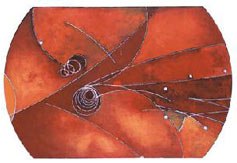

Thursday - March 1, 2007
SLAC Today is
available online at:
http://today.slac.stanford.edu
In this issue:
Exhibition Opening: Lylie Fisher
Science Today: Computer Simulations of Gamma-Ray Bursts
GLAST Mission Operations Center Makes Contact
Registration Now Open for Spring Continuing Studies Courses
 |
 |
|
Thursday - March 1, 2007 |

In Search of Meaning #6
Exhibition Opening: Lylie FisherPlease join artist Lylie Fisher as she unveils her series of physics-themed paintings titled "In Search of Meaning" this evening at 5 p.m. on the second floor of the Research Office Building (Bldg. 48). Fisher's collection visits the lab more than 40 years after SLAC conducted the bubble chamber experiments that inspired her artwork. "My work is an investigation of the nature of life and spiritual reflection, which echoes fundamental questions of particle physics research," said Fisher, who is based in Alameda, California. "This project honors the work of particle physicists, while elevating abstract notions of creation." Bubble chambers are filled with superheated, pressurized liquid; particles passing through them leave a bubbly trail that can be captured on camera. To create her paintings, Fisher enlarged copies of experimental photos to several feet across and added varnishes, layers of resins, and bold pigments to capture the bubbling subatomic particle trajectories. She sees the project as a unification of art and science. "Science is the voice of the rational mind, and art is the reverberation of questioning," she said. "For me, depth of color represents the intellectual and emotional space we inhabit." After the show at SLAC, Fisher's collection will embark on a tour of national and international museums, galleries and laboratories. Visit Fisher's website for more information. |
||
|
|
||
 Computer Simulations
|
GLAST Mission Operations Center Makes ContactThe Gamma-ray Large Area Space Telescope (GLAST) program achieved an operations milestone on February 25th. In a communications test with the GLAST observatory, the Mission Operations Center took control of the Large Area Telescope (LAT) instrument onboard the observatory for the first time. Staff in the LAT Instrument Science Operations Center (ISOC) at SLAC monitored the LAT operations in real-time. The LAT instrument is still on the ground in Arizona, being prepared for flight late this year. The GLAST Mission Operations Center, located at Goddard Space Flight Center in Maryland, sent simple LAT commands to the instrument using flight-like radio-frequency communication. The LAT successfully executed the commands. "Many thanks to all the people in the LAT Integration & Test team, the ISOC and NASA who made this mini end-to-end test a success," said ISOC manager Rob Cameron. Registration Now Open for Spring Continuing Studies CoursesRegistration for spring quarter courses offered by Continuing Studies is now open, and continues through April 4. There are more than 100 courses to choose from, ranging from the liberal arts, foreign languages and studio art to business, personal development and communication. In addition, Continuing Studies is sponsoring 10 free public events in the fields of astronomy, archaeology, music, computer science and photography. This spring there are dozens of new courses to choose from: an archaeology course on Hannibal, an architecture survey from the ancient world to the Baroque, a studio workshop in sports photography, a course on ancient Egyptian hieroglyphs, literature courses on William Blake and Philip Roth, a music course on Bach's partitas and a technology course on the future of the Internet. SLAC employees who work at least half time may use Staff Training Assistance Program (STAP) funds to pay for tuition and registration fees. All courses and programs are open to the public. Click here to register online. |
Events (see all | submit)
Access (see all)
Announcements
|
| | ||
|
|
||
 <%
Response.AddHeader "Last-modified", getArticleDate()
'Response.AddHeader "Last-modified","Mon, 01 Sep 1997 01:03:33 GMT"
'Monday, December 06, 2010
%>
<%
Response.AddHeader "Last-modified", getArticleDate()
'Response.AddHeader "Last-modified","Mon, 01 Sep 1997 01:03:33 GMT"
'Monday, December 06, 2010
%>View online at http://today.slac.stanford.edu/. |
||